Mountain Dog Breeds
Posted on April 26, 2023 • 14 min read • 2,972 wordsDiscover the charm of Mountain Dog Breeds

It’s no surprise that mountain dog breeds have captured the hearts of dog enthusiasts worldwide. These majestic canines have strength, loyalty, and breathtaking beauty, making them a unique species to explore.
Adapted to their harsh mountainous environments, they have been dependable working dogs in herding, guarding, and search and rescue roles.
In this blog post, we’ll dive into the fascinating world of mountain dog breeds, uncovering their history, purpose, and unique characteristics that set them apart from other dog groups.
Who knows? You may find that a mountain dog breed is the perfect addition to your family.
The Origins and Purpose of Mountain Dog Breeds
Did you know that many mountain dog breeds have been around for thousands of years, with deep roots in history?
These dogs were bred and developed for specific purposes in their native environments, adapting to rugged landscapes and harsh climates through centuries of selective breeding.
Mountain dog breeds have become highly specialized and invaluable partners to the people living in these challenging terrains.
These dogs have traditionally played three primary roles: herding, guarding, and search and rescue. Let’s take a closer look at each of these essential tasks:
Herding
They were responsible for managing large flocks of sheep or cattle, ensuring their safety from predators, and guiding them between pastures.
Breeds like the Bernese Mountain Dog and the Pyrenean Shepherd were often employed as herding dogs by shepherds in their native regions.
Their intelligence, agility, and incredible work ethic made them invaluable assets to their human counterparts, and they continue to serve as excellent herding dogs today.
Guarding
Many mountain dog breeds were also developed to be effective livestock guardians, protecting their charges from threats like wolves, bears, and other predators.
Breeds like the Great Pyrenees and the Anatolian Shepherd were bred to be courageous, strong, and fiercely loyal to their families and flocks. These dogs vigilantly patrol their territories, using their imposing size and strength to deter predators and keep their charges safe.
Search and Rescue
The exceptional strength, stamina, and intelligence of mountain dog breeds also made them ideal candidates for search and rescue work, particularly in challenging alpine environments.
Breeds such as Saint Bernard and the Newfoundland were renowned for locating and rescuing lost or injured travelers in harsh, snowy conditions.
Their thick, insulating coats and incredible physical endurance enabled them to traverse rugged terrains, while their keen sense of smell and strong instincts made them expert trackers.
These magnificent dogs continue to serve their original purposes while also making loyal and loving companions for families worldwide. Their unique strength, adaptability, and unwavering devotion to their human partners make them exceptional canine companions.
Popular Mountain Dog Breeds and Their Characteristics
The Bernese Mountain Dog is a large, sturdy breed originating from Switzerland. They have a thick, tri-colored coat consisting of black, white, and rust markings.
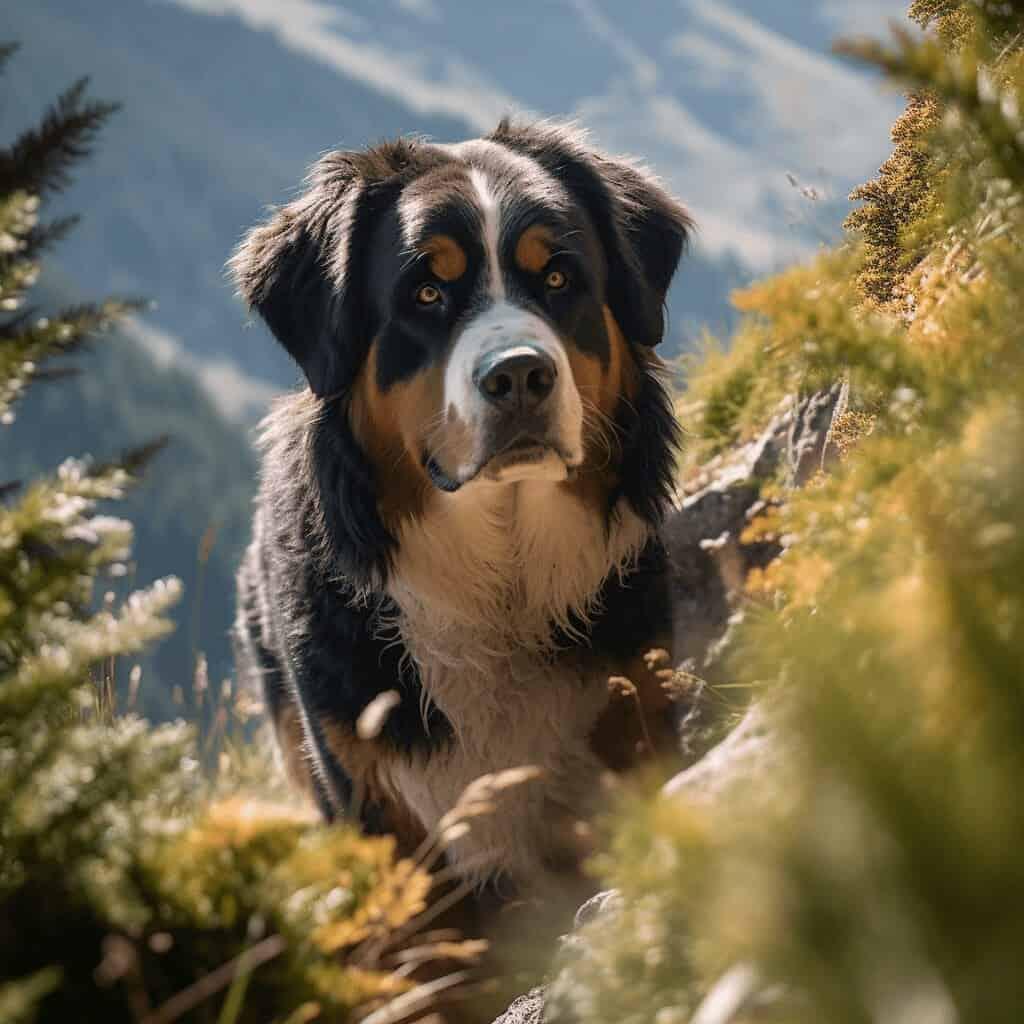
These dogs are known for their friendly, gentle temperament and strong work ethic. Bernese Mountain Dogs are highly intelligent, making them excellent working dogs and family pets. They are also known for their loyalty and strong bond with their families.
The Great Pyrenees is a majestic, large breed with a thick, weather-resistant white coat. Originating from the Pyrenees Mountains between France and Spain, these dogs were bred to guard livestock from predators.
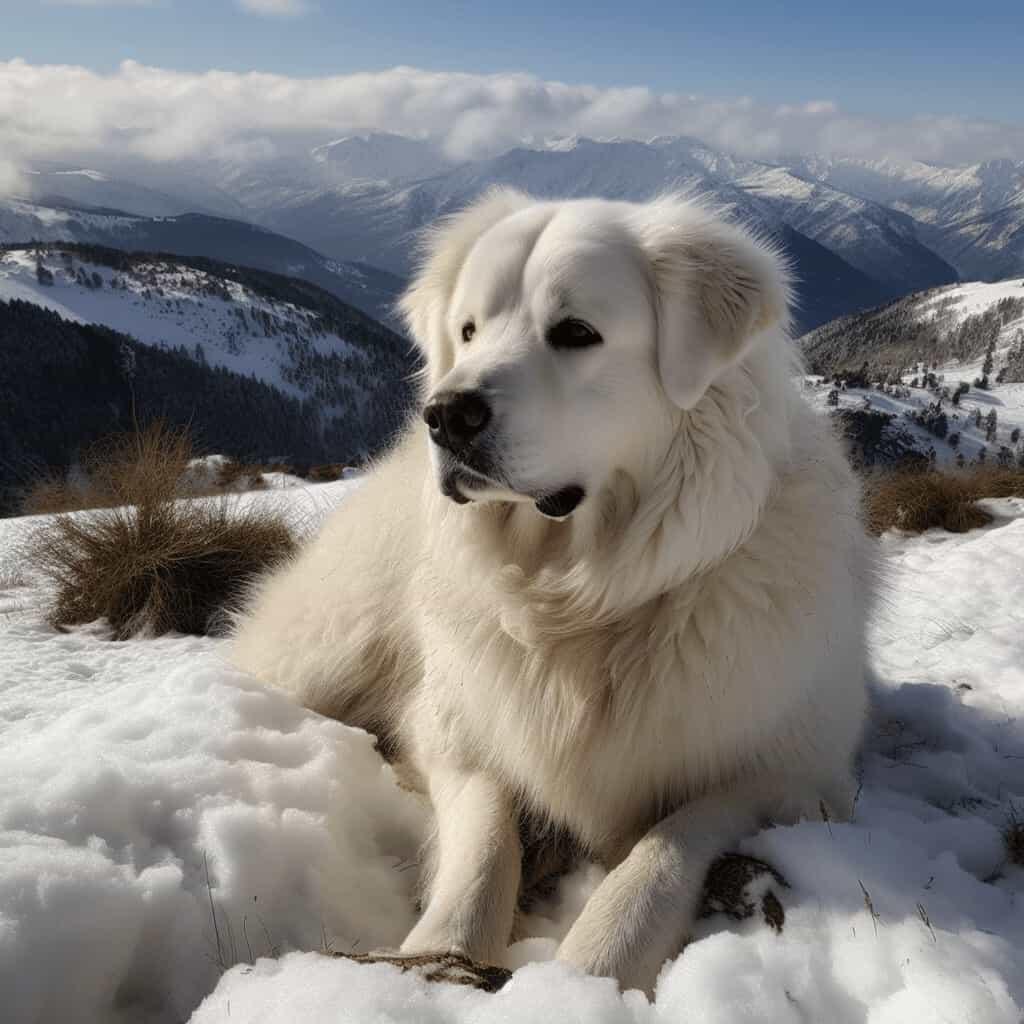
They possess a calm and gentle disposition but are also highly protective of their families and charges. Great Pyrenees dogs are independent thinkers, making them excellent guardians and loyal companions.
The Saint Bernard is a massive, muscular breed from the Swiss Alps. They are renowned for their search and rescue abilities in snowy conditions.
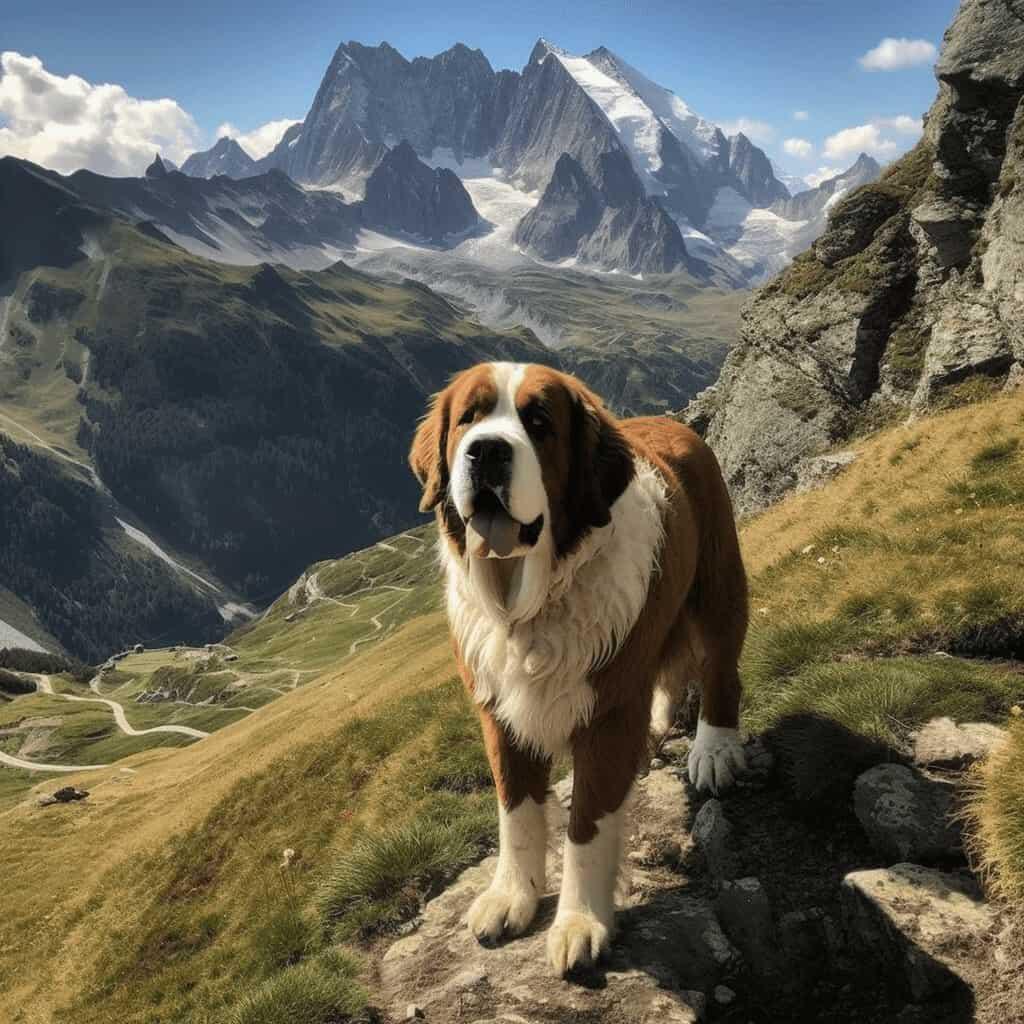
Saint Bernards have a dense, smooth, or rough coat and typically have reddish-brown and white markings. These gentle giants are known for their friendly, calm temperament and devotion to their families.
Newfoundlands are large, powerful dogs originating in the Canadian province of Newfoundland and Labrador. They have a thick, water-resistant double coat and webbed feet, which make them excellent swimmers.
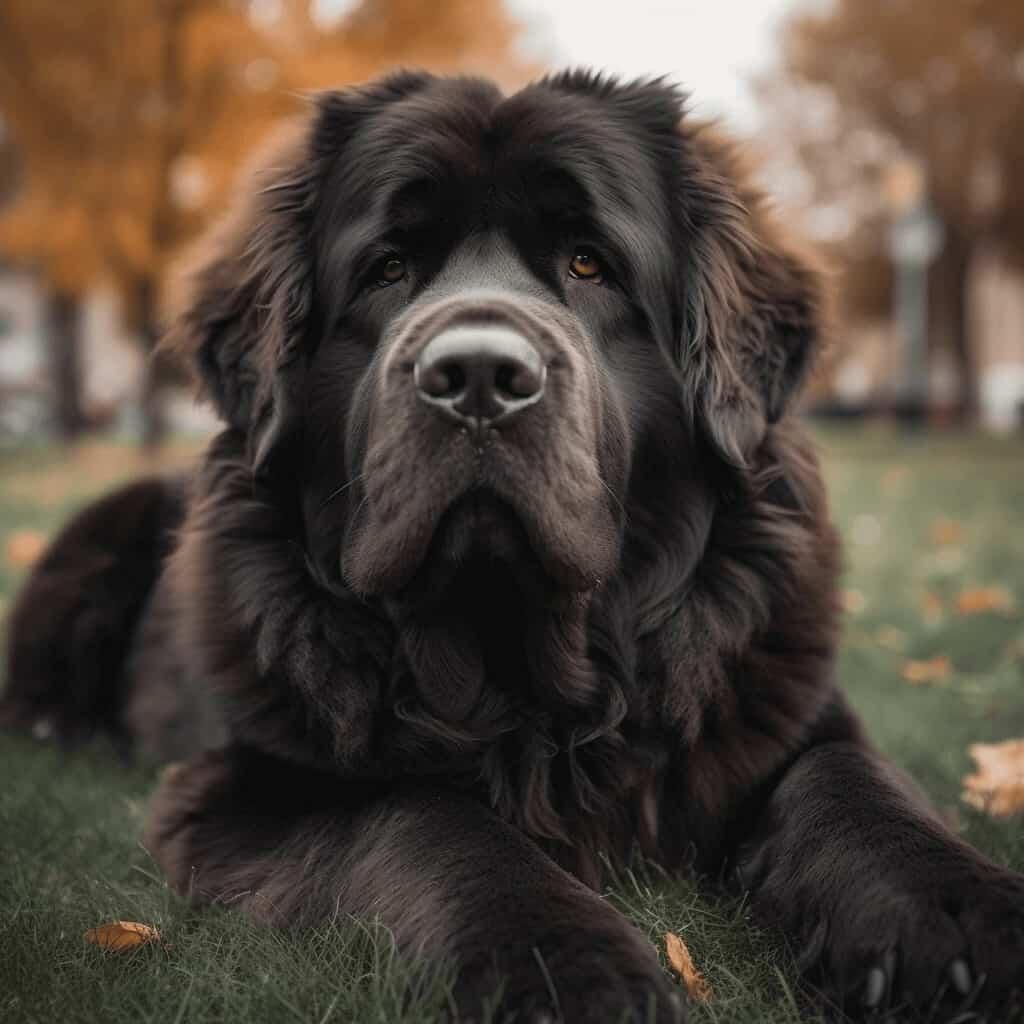
Newfoundlands are known for their gentle and sweet nature, making them excellent family pets. These dogs excel in water rescue work and intuitively save people in distress.
**The Tibetan Mastiff **is an ancient breed originating from the high altitudes of the Himalayan Mountains. They are large and powerful dogs with thick, dense coats in various colors, including black, brown, and blue-gray.
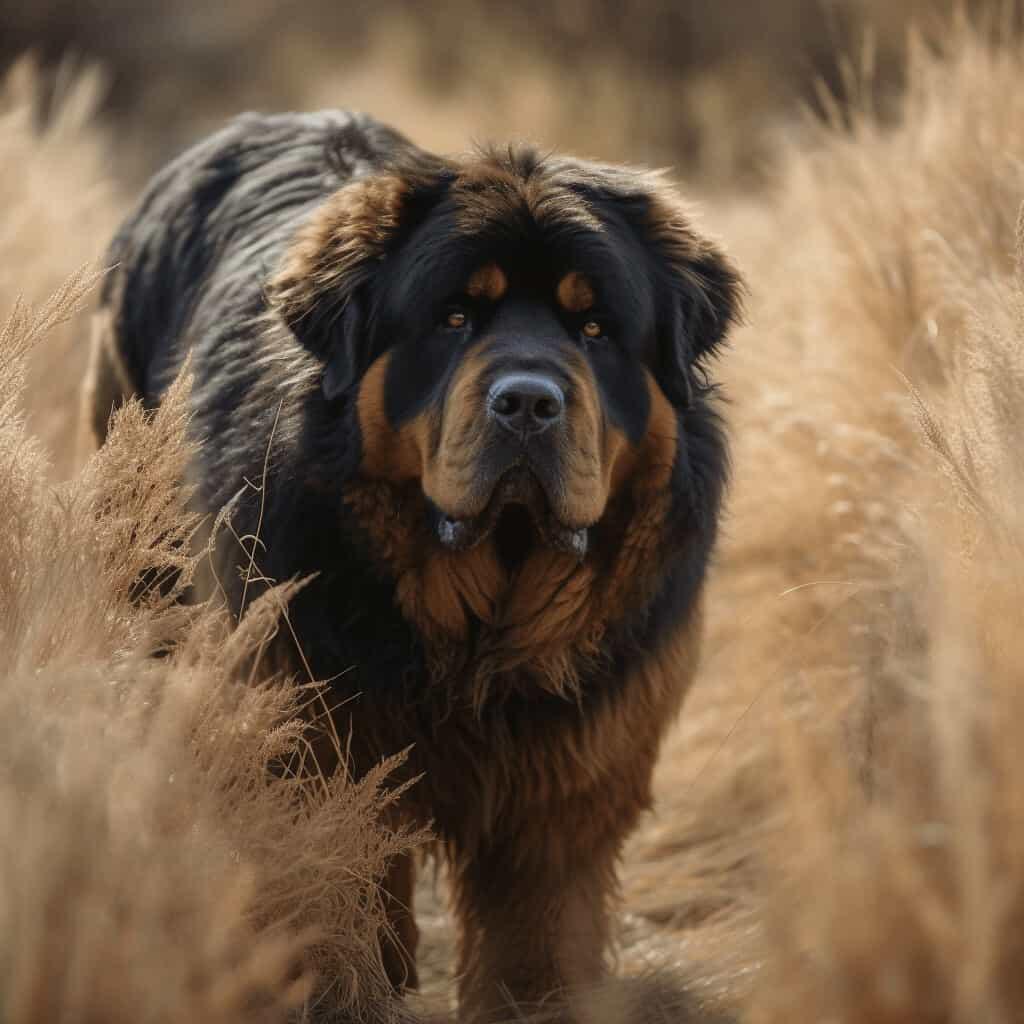
Tibetan Mastiffs are known for their independent nature and strong protective instincts. They are loyal and devoted to their families but can be aloof with strangers.
The Appenzeller Sennenhund is a medium-sized breed from Switzerland, bred for herding and guarding livestock. They have a dense, tricolor coat, which is black or brown with white and rust markings.

Appenzeller Sennenhunds are intelligent, energetic, and versatile dogs that excel in various activities, including herding, agility, and obedience. They are loyal and protective of their families and make excellent watchdogs.
The Anatolian Shepherd is a large, powerful breed native to the Anatolian Plateau in Turkey. They were bred to guard livestock from predators and have short to medium-length, dense coats that can be of various colors.

Anatolian Shepherds are known for their intelligence, independence, and strong protective instincts. They are loyal and devoted to their families but may be reserved with strangers.
These dogs are best suited to experienced dog owners who can provide consistent training and socialization.
The Adaptability of Mountain Dog Breeds
Mountain dog breeds are remarkable creatures with a long history of adapting to different roles and environments. They possess unique characteristics that enable them to excel in various settings, from family pets to working dogs.
One of the key factors that contribute to their adaptability is their intelligence. Mountain dog breeds have been bred for centuries to think independently, so they can quickly learn and adapt to new situations. Their intelligence suits them for various tasks, including herding, guarding, and search and rescue.
In addition, their physical strength and endurance are also essential to their adaptability. They are built to withstand the challenges of rugged terrain and extreme weather conditions, making them well-suited for outdoor activities and sports, such as hiking, agility, and even sledding.
Mountain dog breeds also have an exceptional temperament, which makes them adaptable to various households. They are known for being gentle, loyal, and protective, making them excellent family pets.
They have a strong protective instinct that ensures they care for their families and get along well with other animals, making them suitable for households with multiple pets.
Moreover, these dogs have succeeded as therapy and service dogs in recent years. They can provide emotional support and assistance to individuals with disabilities, helping to improve their quality of life.
Their calm, gentle nature, intelligence, and trainability make them ideal candidates for these crucial roles.
Health and Lifespan Considerations for Mountain Dog Breeds
While mountain dog breeds are known for their strength and adaptability, they can still be prone to specific health concerns and have varying lifespan expectations.
Owners must be aware of these issues and take proactive steps to ensure their dogs maintain optimal health and well-being.
Common Health Concerns:
Hip and Elbow Dysplasia: Many mountain dog breeds are susceptible to hip and elbow dysplasia, a hereditary condition that can lead to joint pain, arthritis, and mobility issues. Regular veterinary check-ups and maintaining a healthy weight can help prevent or manage these conditions.
Bloat: Large, deep-chested breeds like Great Pyrenees and Bernese Mountain Dogs are at risk for bloat, a life-threatening condition where the stomach fills with gas and twists on itself. Feeding smaller meals more frequently and avoiding vigorous exercise around meal times can reduce the risk.
Heart Issues: Some mountain dog breeds may be prone to certain heart conditions, such as dilated cardiomyopathy and aortic stenosis. Regular veterinary exams can help detect these issues early, and treatment options may include medication or surgery.
Eye Problems: Mountain dogs breeds, like the Newfoundland and Saint Bernard, can be prone to eye conditions such as entropion, cataracts, and progressive retinal atrophy. Regular eye exams and early intervention can help maintain good vision.
Lifespan Expectations
The average lifespan of mountain dog breeds varies depending on the breed, with smaller breeds typically having longer lifespans.
For example, Appenzeller Sennenhunds can live up to 13 years, while larger breeds like Saint Bernard and Newfoundland may have an average lifespan of 8 to 10 years.
Tips for Maintaining Optimal Health and Well-being:
Balanced Diet: Feeding your mountain dog a balanced, high-quality diet specific to their age, size, and activity level is crucial for overall health and longevity.
Regular Exercise: Mountain dog breeds require regular exercise to maintain a healthy weight, prevent joint issues, and provide mental stimulation. Choose activities suitable for your dog’s size, age, and fitness level, such as walks, hikes, or playtime.
Veterinary Care: Regular veterinary check-ups, vaccinations, and preventive care are essential to catch and treat any health issues early.
Grooming: Many mountain dog breeds have thick, double coats that require regular grooming to prevent matting, remove loose hair, and promote skin health.
Mental Stimulation: Providing toys, puzzles, and engaging activities can help prevent boredom and keep your dog’s mind sharp.
By being aware of common health concerns and lifespan expectations and taking steps to maintain optimal health and well-being, you can help ensure your mountain dog enjoys a happy, healthy life by your side.
Training and Socialization Tips for Mountain Dog Breeds
Raising a happy and healthy mountain dog involves proper training and socialization from an early age.
These breeds are known for their impressive size, strength, and instincts, which makes it crucial to teach them good behavior and interaction with others.
Whether your mountain dog is a guard, herder, or search and rescue dog, effective training methods can help them become a well-behaved and friendly companion. With patience and consistency, you can ensure that your mountain dog enjoys a fulfilling and happy life with you.
Early socialization and training shape your mountain dog’s temperament and behavior. Exposure to various people, animals, and environments during their critical developmental period (between 3 and 14 weeks) will help them become well-adjusted adults.
Proper socialization can prevent fearfulness, aggression, and other unwanted behaviors, allowing your dog to navigate different situations confidently.
Guidance on Managing Their Size, Strength, and Natural Instincts:
Start Early: Begin training your mountain dog as a puppy when they are more manageable in size and eager to learn. This will establish a strong foundation for lifelong learning and help prevent issues related to their size and strength from developing later.
Consistency and Positive Reinforcement: Use consistent commands and positive reinforcement techniques, such as treats, praise, and playtime, to encourage desired behaviors. This approach helps create a strong bond between you and your dog while making training an enjoyable experience for both of you.
Obedience Training: Teach your mountain dog basic obedience commands like “sit,” “stay,” “come,” and “heel.” These commands will help you manage their size and strength while keeping them safe and under control in various situations.
Leash Training: Due to their size and strength, mountain dog breeds should be taught to walk politely on a leash without pulling. Use a sturdy, well-fitting harness and employ training techniques that reward calm behavior and discourage pulling.
Socialization: Expose your mountain dog to different people, animals, and environments to help them learn how to interact appropriately. Supervise interactions with other dogs, especially if your mountain dog has strong guarding or herding instincts, to prevent any issues from arising.
Address Natural Instincts: If your mountain dog breed has strong herding or guarding instincts, provide appropriate outlets for these behaviors. For example, consider enrolling them in herding trials or training classes, or provide structured activities that allow them to use their instincts in a controlled manner.
Professional Assistance: If you encounter difficulties with training or socialization, consider seeking the help of a professional dog trainer or behaviorist. They can offer valuable guidance and resources tailored to your dog’s needs and breed traits.
Grooming and Maintenance for Mountain Dog Breeds
Regular grooming is essential to maintain their coat’s health, minimize shedding, and promote overall hygiene. Mountain dog breeds often have unique grooming needs due to their thick, double-layered coats, which help them withstand harsh weather conditions.
Here are some tips to help you care for your mountain dog’s coat and maintain their overall well-being.
Brushing: Mountain dog breeds typically have dense coats that require regular brushing to prevent matting and reduce shedding. Depending on the breed, you may need to brush your dog’s coat daily or at least a few times a week. Use a slicker or rake-style brush for double-coated breeds to effectively remove loose hair and prevent tangles.
Bathing: Bathe your mountain dog as needed, depending on their activity level and exposure to dirt or debris. Most mountain dogs will require a bath every 1-3 months. Always use a gentle, dog-specific shampoo that won’t strip the natural oils from their coat. Make sure to rinse out any soap to avoid skin irritation thoroughly.
Ear Care: Regularly check and clean your mountain dog’s ears to prevent infections. Use a soft, damp cloth or a cotton ball soaked in a dog-specific ear cleaner to clean the outer ear gently. Never insert anything into the ear canal, which can cause injury or push debris further in.
Nail Trimming: Trim your mountain dog’s nails every 3-4 weeks or as needed to prevent overgrowth and discomfort. Use a pair of dog-specific nail clippers or a rotary nail grinder, and be cautious not to cut the quick (the blood vessel inside the nail), which can cause pain and bleeding.
Dental Care: Maintain your mountain dog’s dental hygiene by brushing their teeth at least a few times a week with a dog-specific toothpaste and toothbrush. You can also provide dental chews or toys to help keep their teeth clean. Regular dental care can prevent bad breath, gum disease, and tooth loss.
Seasonal Grooming: Mountain dog breeds may require additional grooming during seasonal shedding. During these times, you may need to brush your dog more frequently and consider using a de-shedding tool to help remove excess undercoat.
Professional Grooming: While most grooming tasks can be done at home, you may seek a professional groomer’s assistance for more complicated tasks or breed-specific grooming requirements. A professional groomer can also provide valuable advice on maintaining your mountain dog’s coat and overall hygiene.
Regularly attending to your mountain dog’s grooming needs and maintaining their overall hygiene will keep them looking their best and promote their health and well-being.
Choosing the Right Mountain Dog Breed for You
Selecting the perfect mountain dog breed for your lifestyle and needs is essential to ensure a harmonious relationship between you and your new canine companion.
By considering factors such as size, temperament, and activity level, you can narrow your options and make an informed decision.
Here are some factors to consider when selecting a mountain dog breed, along with tips for finding a reputable breeder or rescue organization.
Size and Space Requirements: Mountain dog breeds range from medium to giant sizes, so consider the amount of space you have both indoors and outdoors. Ensure you have enough room in your home and yard to accommodate the breed’s size and exercise needs.
Temperament: Each mountain dog breed has a unique character, so consider which traits best suit your family and lifestyle. Some species are more protective and independent, while others are friendly and pleasant. Be honest about your ability to manage a particular breed’s temperament and needs.
Activity Level: Mountain dog breeds typically require regular exercise to maintain health and happiness. Consider your activity level and the time you’re willing to devote to walking, playing, and engaging with your dog.
Grooming and Maintenance: As mentioned earlier, mountain dog breeds often have unique grooming needs. Consider the time and effort you will put into maintaining your dog’s coat and overall hygiene.
Health and Lifespan: Research the common health concerns and lifespan expectations for the breeds you’re considering. This information can help you make an informed decision and prepare for potential health issues.
Training and Socialization: Be prepared to invest time and effort into early socialization and training for your mountain dog. This will help ensure a well-rounded and well-behaved canine companion.
Once you have considered these factors and narrowed your options, it’s time to find a reputable breeder or rescue organization.
Research Breeders: Look for breeders with a solid reputation and a history of producing healthy, well-tempered dogs. A good breeder will prioritize health testing, responsible breeding practices, and the welfare of their dogs. Ask for referrals from breed-specific clubs, veterinarians, or other dog owners.
Ask Questions: When contacting a breeder, don’t hesitate to ask about their breeding practices, the dogs’ health history, and the parent’s temperament. A reputable breeder will be more than happy to answer your questions and provide you with relevant information.
Visit the Breeder: Arrange a visit to the breeder’s facility to see the conditions in which the dogs are raised and meet the puppies parents. This will give you valuable insight into the dogs’ temperaments and how they are cared for.
Consider Rescue Organizations: If you’re open to adopting a mountain dog, research breed-specific rescue organizations. These groups often have dogs of various ages and backgrounds needing loving homes. Some rescue dogs may require extra care, patience, and training.
By carefully considering your needs and preferences and thoroughly researching breeders or rescue organizations, you can find the perfect mountain dog breed to become a cherished family member.
Not a fan of Mountain Breed dogs? Perhaps an Italian breed would suit your preferences better. Check out our post on Italian breeds.